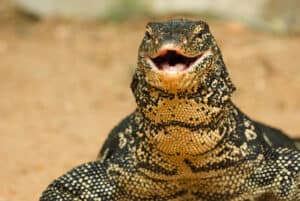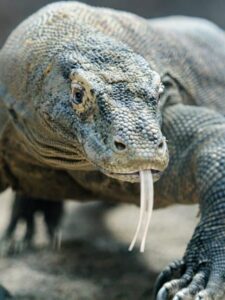Did you know that savannah monitors are the most common pet lizard species? Half of the international monitor lizard trade implies savannah monitors! On the other hand, they’re also the most common monitor lizards in animal rescue centers because their owners often find it difficult to care for them, and they become unwanted pets.
We’ll talk about what they eat in the wild and share some tips on how to feed them at home in an effort to help preserve their population.
What Are Savannah Monitors?
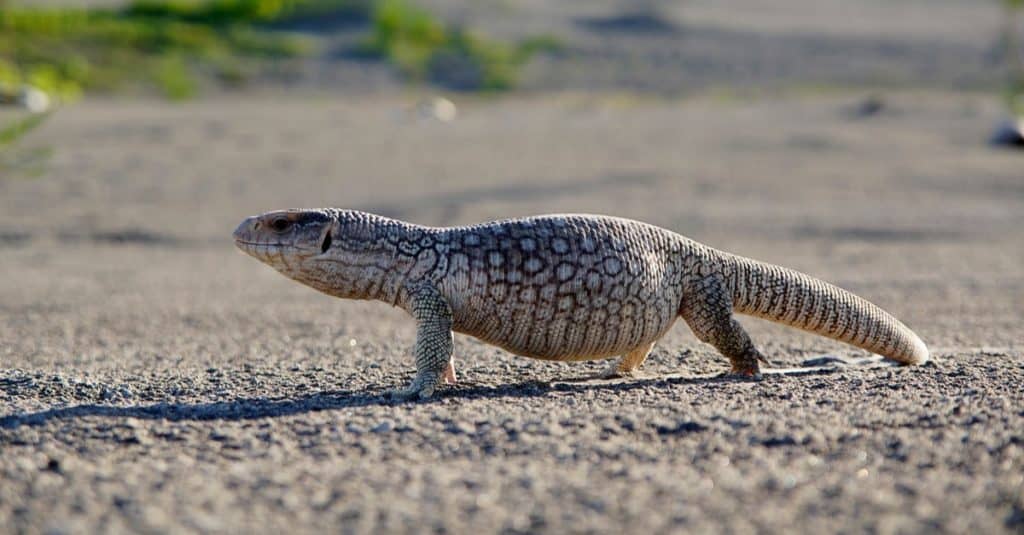
Savannah monitors are monitor lizards, scientifically called
Varanus exanthematicus.
©Fuadi Afif/Shutterstock.com
Savannah monitors are monitor lizards, scientifically called Varanus exanthematicus. These lizards are sometimes called Bosc’s monitors because they were first described by the French scientist Louis Bosc. They are native to Africa, and their current range extends from Senegal east to Sudan. They prefer living in burrows, near bushes or low trees.
Savannah monitors have a maximum length of 39.4 inches. They have relatively short but powerful limbs and toes, a robust build, and strong jaws. Savannah monitors have almost 100 large scales around their midbody. Their skin color depends on their habitat’s substrate.
What Do Savannah Monitors Eat in the Wild?
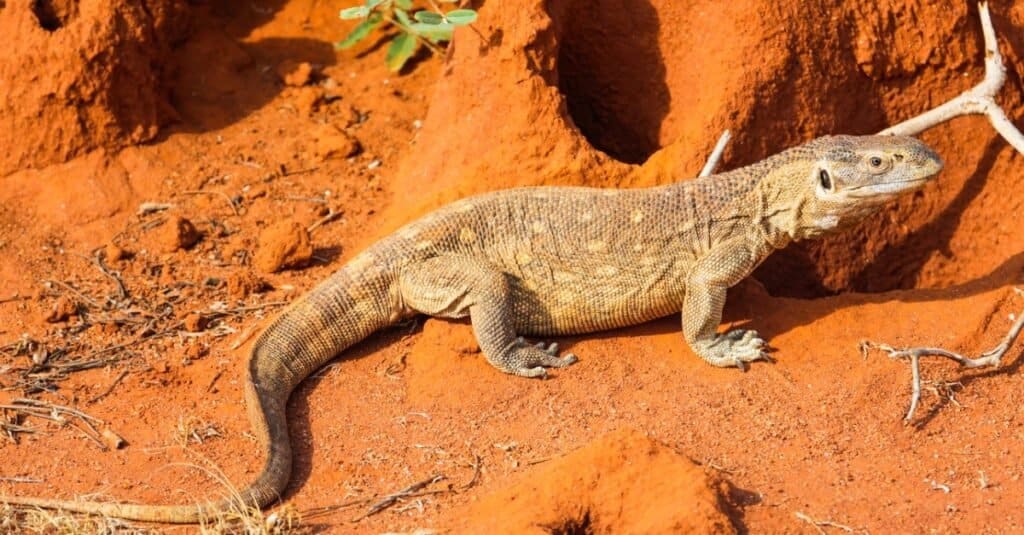
Savannah monitors eat snails, orthopterans, millipedes, beetles, and other invertebrates.
©iStock.com/MariusLtu
Savannah monitors are carnivores and primarily eat snails, orthopterans, millipedes, beetles, and other invertebrates. Some studies focused on savannah lizards from Senegal and Ghana showed that they ate mostly mollusks and arthropods. In Ghana, young savannah monitors ate almost exclusively small crickets and switched to feeding on scorpions, amphibians, and orthopterans as they matured. Adults were very fond of snails and consumed them in large quantities. On the other hand, in Senegal, savannah monitors ate almost exclusively Julus millipedes.
They are opportunistic and even aggressive eaters, so, despite their preferences, they’ll eat almost anything they stumble upon.
A List of Foods Savannah Monitors Eat
Here’s a list of foods savannah monitors eat:
- Beetles
- Crickets
- Grasshoppers
- Millipedes
- Snails
- Superworms
- Cockroaches
- Crayfish
- Silkworms
- Orthopterans
What Should You Feed Your Pet Savannah Monitor?
Your savannah monitor’s diet should be high in protein. You can give it large insects, such as large crickets, king mealworms, super worms, grasshoppers, silkworms, cockroaches, and crayfish. You can sometimes offer waxworms, but not too often because they have high fat levels.
Cooked egg whites are also a great source of protein. Besides this, you’ll need to provide it with supplements rich in calcium gluconate or calcium carbonate that are low in phosphorus. Don’t give them products and supplements rich in vitamin D because it’s toxic to savannah monitors.
Some sources state that you can also feed your savannah monitor greens, such as endive, dandelion greens, escarole, collard greens, or turnip greens. However, since these lizards are primarily carnivores and their diet focuses on insects, we recommend checking with the veterinarian before including greens in their diet.
You’ll have to ensure your savannah monitor has fresh water every day.
How Often Do You Feed Savannah Monitors?
If you have a young savannah monitor, you should feed it every day, and its diet should primarily consist of insects alongside a few small pieces of boiled eggs. Once they grow older, you can also give them pinkie and fuzzy mice and start feeding them 3 – 4 times a week. You can also include earthworms, roaches, and fish pieces in their diet.
Once they reach sexual maturity, roughly when they’re two years old, savannah monitors can switch to an adult diet, meaning they can generally be fed 2 – 3 times a week, depending on how much they weigh. If they are prone to obesity, you should reduce their food intake. However, since savannah monitors are prone to becoming obese, while others may reach the other extreme, anorexia, we strongly recommend asking your veterinarian for advice.
What Meat Can a Savannah Monitor Eat?
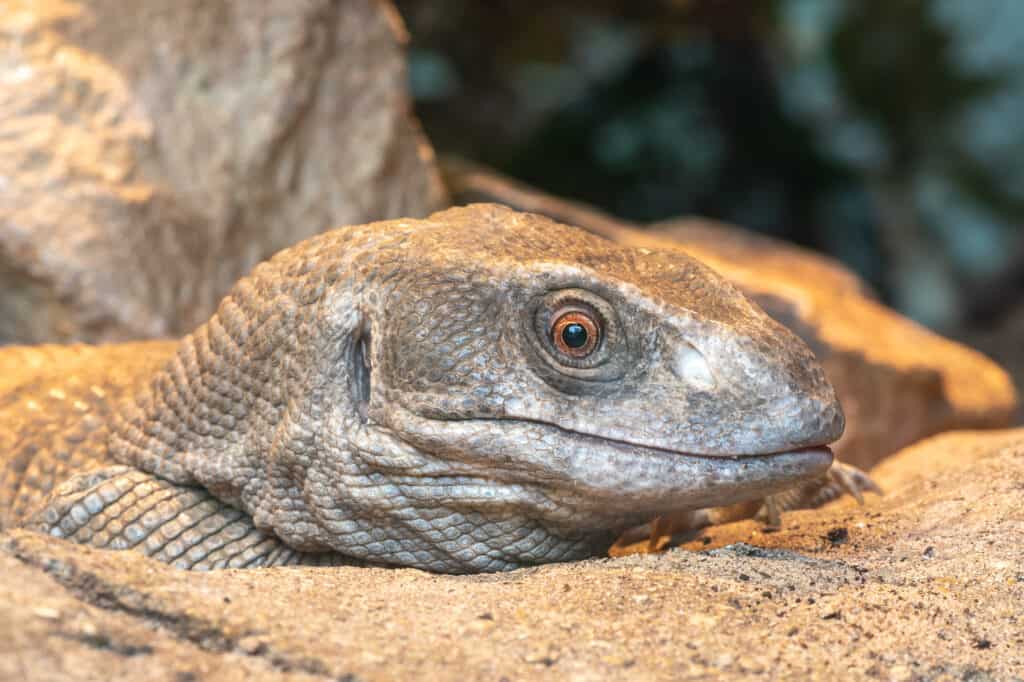
Savannah monitors can eat cooked chicken breasts.
©iStock.com/Tom Meaker
Before giving your savannah monitor meat, you should consider how much fat the meat consists of because its liver cannot handle too much fat. Savannah monitors can eat cooked chicken breasts. In fact, cooked chicken is often used as a treat and reward during training. Turkey breasts will make it happy, too! You can also feed it whole, lean, freshwater fish.
However, do not overfeed it with meat, as it should only be a diet supplement.
Do Savannah Monitors Make Good Pets?
While savannah monitors are the “sweetest” of their relatives, they can still bite or scratch you. It’s important to learn your savannah monitor’s behavior. You shouldn’t try to calm it down or handle it if it hisses, stands on the hind limbs, or exhibits other threatening behaviors. Moreover, you should never approach it rapidly or unexpectedly because it will consider you a threat. Slow movements are the secret to helping your savannah monitor trust you. Experts also advise against handling your monitor after you handle its food. It’s best if you could wash your hands first.
To help your savannah monitor familiarize itself with you, you can ensure daily contact that would eventually help it feel safe around you. Make sure to regularly trim your savannah monitor’s nails because they can become quite sharp.
Savannah monitors can develop obesity and fatty liver disease, so a well-adjusted and balanced diet will help your lizard stay healthy. It might even require regular exercise.
Savannah Monitor: Predators and Threats
Savannah monitors don’t have many predators in the wild, some of them being birds and snakes. Their biggest predators are humans, who hunt them for their meat, leather, and the international pet trade.
Up Next:
The photo featured at the top of this post is © iStock.com/MariusLtu
Sources
- Animal Diversity Web, Available here: https://animaldiversity.org/accounts/Varanus_exanthematicus/
- Reptile Supply, Available here: https://reptilesupply.com/blogs/monitor-lizards/what-can-my-savannah-monitor-eat
- Chicago Exotics Animal Hospital, Available here: http://www.exoticpetvet.com/savannah-monitor-care.html
- The Spruce Pets, Available here: https://www.thesprucepets.com/savannah-monitors-1239214
Thank you for reading! Have some feedback for us? Contact the AZ Animals editorial team.



